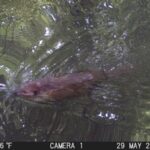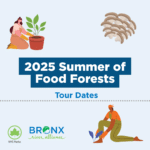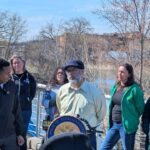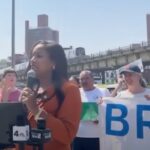It would be a considerable understatement to say that 2020 has been a rough year, especially for communities like The Bronx, the hardest hit by Covid-19 of the NYC boroughs, where residents were twice as likely to die from the disease during the worst months of the pandemic than their neighbors in Manhattan. This stark reality has irrevocably changed life for the majority of The Bronx’s 1.4 million residents.
But it was against the backdrop of this crisis that 32 eager high school students turned to their own communities’ green spaces for a source of relief and, in turn, to offer aid. Through a new innovative grant program called the Green Relief and Recovery Fund, funded by the Leona M. and Harry B. Helmsley Charitable Trust, these students became the Bronx River Alliance’s first cohort of EELS Interns (Environmental Enrichment and Leadership for Students). The program, which took place over 4-weeks from mid-July to mid-August, consisted of at-home virtual classrooms and in-person park stewardship designed to expose the students to the ecological wonders of The Bronx, perhaps for some, for the very first time.
Designed specifically to bring relief to students during an unprecedented time of upheaval, this educational initiative was unique in many respects. First and foremost, it offered students a desperately needed connection to their peers after nearly 6 months of quarantining at home. Half of the 32 interns completed the program entirely remotely, participating in two virtual sessions a week, alongside completion of individual activities designed to get them out and exploring their own neighborhoods.
The remaining students—those who live close enough to one of two parks in the South Bronx designated for the program—completed weekly stewardship projects in addition to the virtual curriculum. They met up in groups of 8 students and 2 instructors to ensure proper physical distancing, and completed projects vital to the maintenance of these community spaces: mulching, weeding, water quality monitoring, harvesting from Concrete Plant Park’s Foodway, (link to FW) and more. In doing so, the students were gaining valuable skills while feeling a sense of accomplishment for bettering their community.
The curriculum itself was created to introduce students to the rich ecological resources available in their borough at a time when traveling to more “natural” areas is not an option for most. Each week students engaged in lessons on a different topic related to the social and natural history of The Bronx and its eponymous river. Week One focused on issues around water- where our drinking water comes from, the importance of water quality monitoring, and the issues with NYC’s Combined Sewer Overflow System (link to CSO info). Week Two delved into the ecology of the flora and fauna that is found in the Bronx River Watershed and our duty to preserve its biodiversity. Next, Week Three introduced the students to the Indigenous history of the borough and the subsequent history, including Urbanization, that has transformed The Bronx into what we see today. And finally, Week Four allowed students to engage in thoughtful discussion about creating a sustainable future for our urban landscapes and how they can affect change in their own communities.
And yet another unique aspect of this program was its focus, not solely on academic topics, but on introducing the students to the various environmental career pathways available to them right in their borough and wider NYC. Each week, guest speakers joined the virtual sessions to share their career journeys. The speakers, in addition to working in environmental organizations from around the city, were representatives of the same neighborhoods and communities as the students, and were able to demonstrate that the students too can pursue such rewarding careers.
Finally, and perhaps most importantly, this program distinguishes itself from others due to its dedication to financially compensating the interns for their time and hardwork. The Bronx River Alliance and its partner organizations strongly believe that this is the only equitable way to offer advancement opportunities to youth who might otherwise have to work a paying job, perhaps to help support their family or for other reasons. The grant funding provided by the Green Relief and Recovery Fund allowed for students to pursue their interest in environmentalism no matter their socioeconomic background.
The response from the students after completion of the program has been overwhelmingly positive and even better than we could have hoped. On the last day of the program, the students expressed how much they wished it could continue. Many cited their newfound inspiration to continue environmental studies and pursue an environmental career. Numerous students expressed a renewed appreciation for the green spaces in their own neighborhoods. And several students even regretted the end of the stewardship activities and asked about ways they can continue to be involved! Below are just a few of the students’ sentiments:
“This internship was the highlight of my summer overall, and it was such a privilege to be a part of a group making change and learning about our local ecosystems around us during this pandemic.These weeks made me more aware of how our actions are consequences of the future of our environment and how I am able to change that. This internship gave me the motivation to become the change I want to see in the Bronx.”
“2020 was a rough year, and I feared I wouldn’t be able to reconnect with nature and the great outdoors. However, my time with the Bronx River Alliance taught me that Manice wasn’t my only outdoor home. Instead, they welcomed me to Starlight and Concrete Plant Park, showing that if I ever needed that reconnect, it was right there near my own home. It brought me to appreciate the few parks in the city for what they provide, as a place to rest, relax, and just enjoy the outdoors.”
“I enjoyed this program far more than I ever imagined. I think that it really has opened up my eyes even more than I thought it would. I also think that these past four weeks has made me really question how I can improve the way I live and has even encouraged me to help spread the word about “environment-friendly” living. I am very grateful to be provided an opportunity such as this one because while I did know a good chunk of the information, this program has helped to expand on the topics that I thought I knew in depth. I feel that I have a bigger understanding about the planet I live in and that just intrigues me to learn more.”
As the first cohort of students has graduated from the program, the Bronx River Alliance is already hard at work gathering students’ feedback to formulate the program’s next cohort. As it’s still unclear what the fall will look like in terms of schools reopening, it is tough to say exactly what the next cohort might be like as well. But we do know that there will certainly be another class of EELS to take advantage of this unique opportunity.
About the Bronx River Alliance Education Program
The mission of the Bronx River Alliance is to serve as a coordinated voice for the river and work in harmonious partnership to protect, improve and restore the Bronx River corridor and greenway so that they can be healthy ecological, recreational, educational and economic resources for the communities through which the river flows. Our Education program works as a bridge to connect youth to career opportunities and avenues for engagement in environmental fields. We do this by offering high-quality interactive STEM programming, professional development support for educators, and access to equipment and materials to investigate the rich resources of the Bronx River. Our programming allows for students to authentically engage in science, environmental policy, and community advocacy






